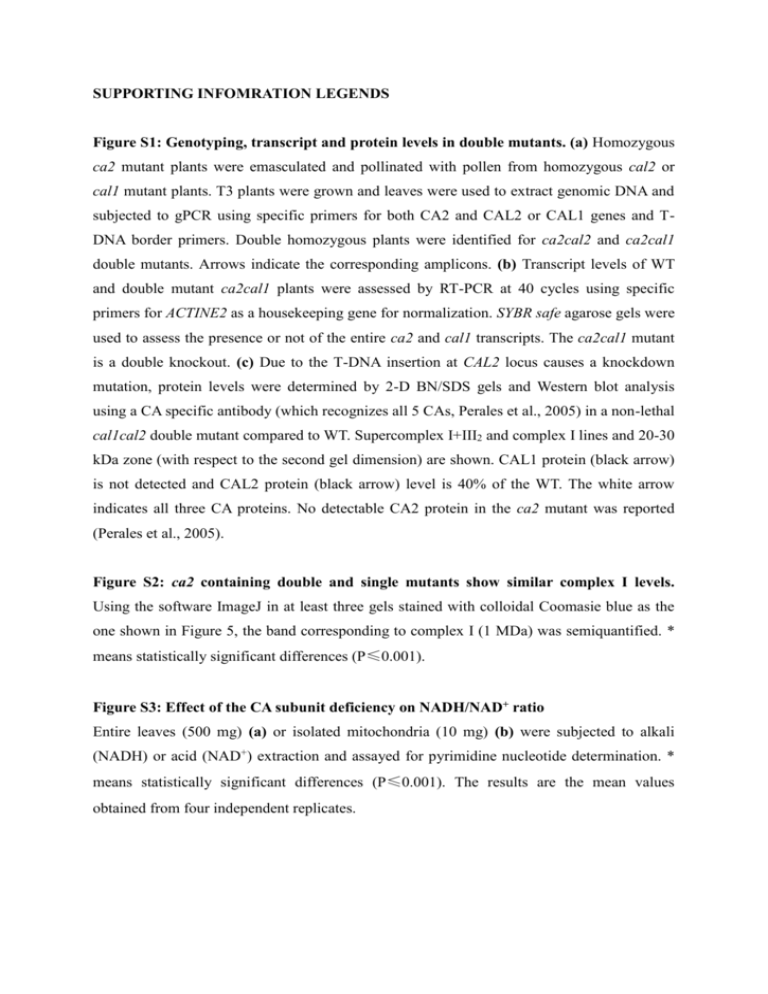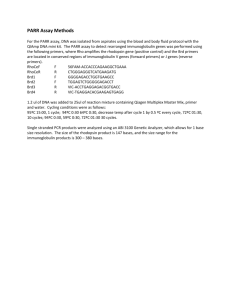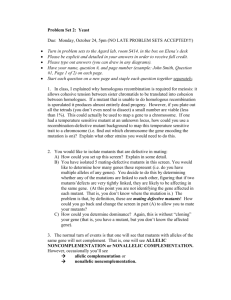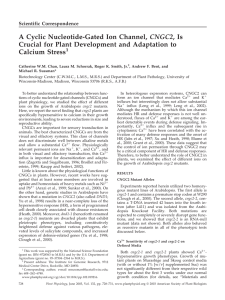tpj12930-sup-0012-Legends
advertisement

SUPPORTING INFOMRATION LEGENDS Figure S1: Genotyping, transcript and protein levels in double mutants. (a) Homozygous ca2 mutant plants were emasculated and pollinated with pollen from homozygous cal2 or cal1 mutant plants. T3 plants were grown and leaves were used to extract genomic DNA and subjected to gPCR using specific primers for both CA2 and CAL2 or CAL1 genes and TDNA border primers. Double homozygous plants were identified for ca2cal2 and ca2cal1 double mutants. Arrows indicate the corresponding amplicons. (b) Transcript levels of WT and double mutant ca2cal1 plants were assessed by RT-PCR at 40 cycles using specific primers for ACTINE2 as a housekeeping gene for normalization. SYBR safe agarose gels were used to assess the presence or not of the entire ca2 and cal1 transcripts. The ca2cal1 mutant is a double knockout. (c) Due to the T-DNA insertion at CAL2 locus causes a knockdown mutation, protein levels were determined by 2-D BN/SDS gels and Western blot analysis using a CA specific antibody (which recognizes all 5 CAs, Perales et al., 2005) in a non-lethal cal1cal2 double mutant compared to WT. Supercomplex I+III2 and complex I lines and 20-30 kDa zone (with respect to the second gel dimension) are shown. CAL1 protein (black arrow) is not detected and CAL2 protein (black arrow) level is 40% of the WT. The white arrow indicates all three CA proteins. No detectable CA2 protein in the ca2 mutant was reported (Perales et al., 2005). Figure S2: ca2 containing double and single mutants show similar complex I levels. Using the software ImageJ in at least three gels stained with colloidal Coomasie blue as the one shown in Figure 5, the band corresponding to complex I (1 MDa) was semiquantified. * means statistically significant differences (P≤0.001). Figure S3: Effect of the CA subunit deficiency on NADH/NAD+ ratio Entire leaves (500 mg) (a) or isolated mitochondria (10 mg) (b) were subjected to alkali (NADH) or acid (NAD+) extraction and assayed for pyrimidine nucleotide determination. * means statistically significant differences (P≤0.001). The results are the mean values obtained from four independent replicates. Figure S4: Quantum yield of PSII and Non Photochemical quenching (NPQ). Fully expanded leaves from plants of the indicated genotypes were subjected to ФPSII (a) and NPQ (b) as indicated in Methods. * means statistically significant differences (P≤0.001). Figure S5: Stomata behavior in double mutants compared to single mutant and WT plants. WT, ca2, ca2cal1 and ca2cal2 plants were grown at ambient CO2, for four weeks. (a) Stomatal index -SI- was determined by counting stomata on representative photographs of the indicated genotypes, (b) stomatal conductance and (c) relative transpiration were determined using a Porometer. Figure S6: Transcript levels of subunits of complex I encoding genes. Plants of the indicated genotypes were grown under ambient conditions as described in Methods for four weeks. Total RNA was extracted and qPCR was performed using specific primers for the indicated genes. Values are normalized using UBQ5 and ACT2 as housekeeping genes. * means statistically significant differences (P≤0.001). Figure S7: Heat map representation of the metabolomic profiling. Log2-fold changes in metabolite levels of WT versus mutants (Table S2) were color-coded and visualized as heat map. Only significant ones are depicted (P<0.05). Strongest Log fold change in glycine with 1.5 compared to WT. Figure S8: Transcript levels of photorespiratory genes. Plants of the indicated genotypes were grown under ambient conditions as described in Methods for four weeks. Total RNA was extracted and qPCR was performed using specific primers for the indicated genes. Values are normalized using UBQ5 and ACT2 as housekeeping genes. * means statistically significant differences (P≤0.001). Table S1: Primers used for genotyping Table S2: Metabolomic profiling of indicated genotypes. Relative metabolite levels per FW measured by GC-MS of whole rosette leaves harvested after six hours in the light period from plants grown (380 ppm CO2) in air at 130 μmol quanta m-2 s-1. The values presented are means ± SE of 4 or 5 biological samples and those set in bold case indicate significant differences to the wild-type values (Student´s t-test P<0.05). Table S3: Metabolic profiling parameters. Metabolite Reporting Checklist showing the parameters used for metabolite annotation of GC-MS analysis as indicated in Fiehn, O. (2007) Concepts in Plant Metabolomics (Berlin: Springer).








